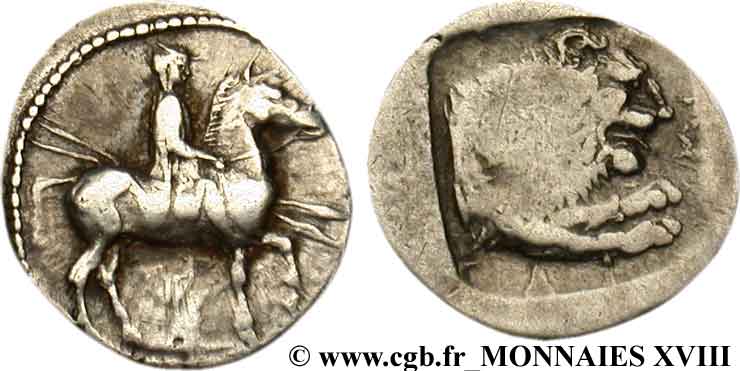AC 167 - Aigai (Perdiccas II), silver, heavy tetrobols (443-437 BCE)
From SILVER
443 BCE - 437 BCE Silver 1,506 kg
Description
| ObverseInscription or printing placed on the obverse.: | Rider in Macedonian dress on horse walking to right, holding two spears in his left hand and the reins in his right |
| ReverseInscription or printing placed on the reverse.: | Forepart of lion to right with protruding tongue, the whole within incuse square |
Mint and issuing power
| MintIdentifies the place of manufacture or issue of a numismatic object.: | Aigai | Ancient regionAncient region.: | Macedon | Modern countryModern country: Greece | AuthorityIdentifies the issuing power. The authority can be "pretended" when the name or the portrait of X is on the coin but he/she was not the issuing power. It can also be "uncertain" when there is no mention of X on the coin but he/she was the issuing power according to the historical sources: | Perdiccas II of Macedon (Argead king, c. 448-c. 413 BC) |
Chronology
| FromIdentifies the initial date in a range assigned in a numismatic context. | 443 BCE | toIdentifies the final date in a range assigned in a numismatic context.. | 437 BCE | PeriodTime period of the numismatic object.: Classical 480-323 BC |
Physical description
| MetalThe physical material (usually metal) from which an object is made.: | Silver |
Median weightMedian of the weights of numismatic objects (in grams). in grams | 2.50 | DenominationTerm indicating the value of a numismatic object. Examples: tetradrachm, chalkous, denarius.: | tetrobol |
StandardStandard.: | Thraco-Macedonian |
Image

AC167 Perdiccas heavy tetrobols.jpg [1]
References
| Die study referencePublication of the study: | Raymond 19531Raymond 1953, n° 176-245 | ||
| Coin series referenceReference to coin series study: | Sear I2Sear I, n° 1490-1492, RQEMAC3RQEMAC, N° 167 | ||
| Coin series web referenceCoin series web references: | |||
Obverse dies distribution
| FrequencyFrequency of specimen in distribution. ᵖ | Number of obversesNumber of obverse dies. ᵖ (o) | % (o) | Number of coinsNumber of coins. (n) | % (n) | Die nameName(s) of the die(s). |
| 1 | 11 | 52.38 | 11 | 22 | 10, 11, 12, 13, 15, 16, 21, 22, 23, 25b, 25c |
| 2 | 3 | 14.29 | 6 | 12 | 18, 20, 24b |
| 3 | 1 | 4.76 | 3 | 6 | 19 |
| 4 | 2 | 9.52 | 8 | 16 | 17, 25a |
| 5 | 2 | 9.52 | 10 | 20 | 14, 24d |
| 6 | 2 | 9.52 | 12 | 24 | 24a, 24c |
| Total | 21 of 21 | 99.99 | 50 of 50 | 100 |
Reverse dies distribution
no distribution is available
Quantification
| Number of obversesNumber of obverse dies. ᵖ (o) | 21 | Number of singletons (o1)The number of singleton coins. ᵖ | 11 |
| Number of reverse diesNumber of reverse dies. (r) | NC"NC" is not a number. | Number of coinsNumber of coins. (n) | 50 |
| Coins per obverse dieNumber of coins per obverse die. (n/o) | 2.38 | Coins per reverse dieNumber of coins per reverse die. (n/r) | |
| Reverse per obverse ratioRatio of obverse dies divided by reverse dies. (r/o) | Percentage of singletons (o1)number of coins (n) divided by the number of singletons (o1) ᵖ | 52.38 % | |
| Original number of dies (O) (Carter 1983 formula)The estimation of the number of coins according to Carter 1983 ᵖ | 30.12 | Coins struck if 20,000 as average productivity per dieCoins made if the average productivity for obverses (according to Carter) is 20,000. ᵖ | 602,400 |
| Original number of dies (O) (Esty 2011 formula)The estimation of the number of coins according to the singleton formula in Esty 2011 ᵖ (O) | 36.21 | Survival rate if 20,000 as average productivity per dieSurvival rate if average productivity is 20,000. ᵖ | 0.00008 |
| Coverage (o = % of O) (Esty 1984 formula)Esty 1984 - coverage (% of O) ᵖ (o = % of O) | 78% | Die productivity if survival rate 1/2,000Average productivity if survival rate is 1/2,000. ᵖ | 3,320.05 |
| Weight of silver (in kg) if 20,000 coins per die (O = Carter formula)Carter 1983 * Median weight * 20000 (*10 if gold or electrum) ᵖ | 1,506 kg <br /> 1,506 kg | Die productivity if survival rate 1/5,000Average productivity if survival rate is 1/5,000. ᵖ | 8,300.13 |
Remarks
References
- ^ Raymond, Doris (1953), Macedonian regal coinage to 413 B.C., Numismatic Notes and Monographs 126, New York, xi, 170 p., 15 pl.
- ^ Sear, David R. (1978), Greek coins and their values. Vol. I, Europe, London, xl, 316 p.
- ^ Callataÿ, François de (2003), Recueil quantitatif des émissions monétaires archaïques et classiques, Numismatique Romaine, Wetteren, VII + 267 p.